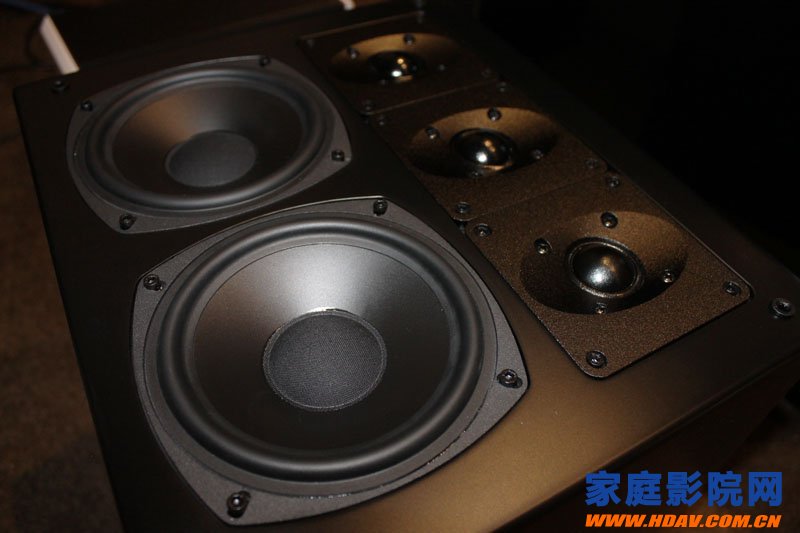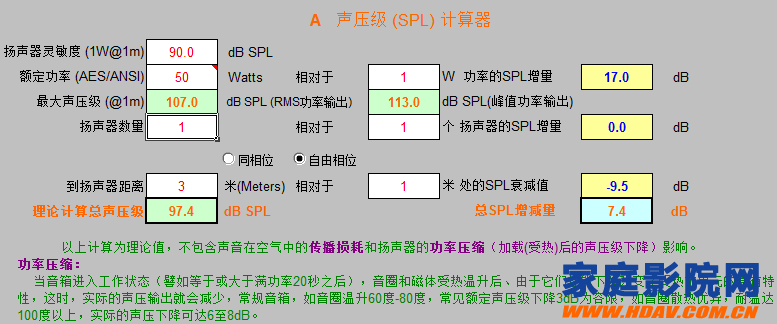[Home Theater Network HDAV.com.cn] The power determines the maximum sound intensity that the speaker can emit. It feels like how loud the sound from the speaker can be. The power of the speaker is not as large as possible. The best is applicable. For a room of 20 square meters for ordinary household users, the true 60W power (the effective output power of the speaker is 30W x 2) is sufficient, but The larger the reserve power of the power amplifier, the better, preferably more than twice the actual output power. First, the sound pressure level calculation formula The following formula is a convenient calculation formula for the sound pressure level at a certain point in the sound field at the r distance: SPL=PWL+10log(Q/(4*3.14*r*r)+4/R), In the formula, SPL: the sound pressure level at the r distance point, the unit (dB), and the sound pressure level reference is 0 dB = 20 μPa. PWL: The sound power level of the sound source, in units of (dB), and the sound power level reference is 0dB=10-12W. Sound power refers to the sound power output on the speaker, not the power output from the amplifier to the speaker. The sound power level is the sound power expressed in decibels. Therefore, the sound power 1W is the sound power level of 120dB. Q: The pointing coefficient of the sound source. 1 When the sound source is in the center of the room, the sound is radiated in a spherical manner, and the pointing coefficient is 1. 2 The sound source is placed in the center of the ground and radiated in a hemispherical manner with a pointing coefficient of 2. 3 placed on the intersection of the two walls, radiated by 1/4 sphere, with a pointing coefficient of 4. 4 placed in the corner of the room, radiated by 1/8 spherical surface, with a pointing coefficient of 8. r: distance from the sound source, unit (m), R: room constant, unit (m2), S: indoor surface area, unit (m2), a: indoor average sound absorption rate, no unit. The room constant R indicates the ability of the room to handle sound, which is related to the wall area and sound absorption capacity of the room. Is the average sound absorption rate, a constant less than one. A room with a relatively active sound like a classroom is about 0.25. A room that lacks reverberation like a bedroom has a good sound absorption of about 0.35. In the formula, Q/4Ï€r2 on the left side of the parentheses indicates the sound pressure of the direct sound, which is inversely proportional to the square of the distance. The 4/R on the right is the sound pressure of the reflected sound associated with the room. The sum of these two terms is the sound pressure generated by the sound source at this point, which is generally expressed in decibels. Since the position of the sound source is usually set to 0 dB, all other points are negative. As long as you know the quantities in the above formula, you can substitute this equation. Second, the sound pressure level attenuation curve is solved When point A is Q=4, R=100, the solution process of the sound pressure level attenuation at a distance of 3m: Find the horizontal line of Q=4 at the pointing coefficient, the right edge to the intersection with the 3m diagonal line, and then vertically find the intersection with the curve of the room constant R=100. This is point A, and then the horizontal to the left edge extends to the intersection of the ordinate, the amount of attenuation of the sound pressure level can be read as 11 dB. Let's take a more practical example, using the latter part of the calculation and the curve to solve the problem. There is a room with a length of 5.4m, a width of 3.6m and a height of 2.5m. The average sound absorption rate of the wall is 0.3. If the sound is placed in front of one wall of the room, with a speaker stand, close to the back wall, the audience is 3m away from the speaker. Ask the amount of sound pressure level attenuation at this time. First of all, no matter which solution is used, the room constant R must be calculated first. Six surface areas of the room: First look at the functional solution process: the left term in the equation is Q/4Ï€r2=2/4Ï€32=0.0177, and the other term on the right is 4/R=4/36=0.125. Therefore, the attenuation of the sound pressure level is 10 log (0.0177 + 0.125) = -8.5 dB. The schematic process is as follows: from the Q=2 line→r=3 line, estimate the position of R=36 in the space of R=20~50, put a little “Bâ€, and then read the attenuation on the ordinate to the left. Yes, it is also more than -8dB. Third, the speaker's output power estimation The above calculated attenuation amount needs to be added to the sound power level PWL to obtain the sound pressure level at that point. So you must also know how to calculate the sound power. The sound power is calculated from the speaker output, so first understand the sensitivity of the speaker or the [output sound pressure level] concept. The sensitivity of the speaker is defined as the 1W electric power input, and the sound pressure level measured at 1m is expressed in dB/W/m. This is an inherent characteristic of the speaker. When this value is 92dB/W/m, the acoustic conversion efficiency of the speaker is 1%. That is, the amplifier needs to output 100W of electric power to exchange 1W of sound power. If the sensitivity is less than 92 dB/W/m, then 100W of electric power will not be replaced by 1W of sound power, and the difference of 3dB will be doubled. For example, a speaker with a sensitivity of 89 dB/W/m requires 200 W of electric power to get 1 W of sound power, while a 86 dB/W/m speaker requires up to 400 W of electric power to obtain 1 W of sound power. With these relationships, the electric power can be converted into sound power PWL, PWL = 10 log (sound power output W/10-12W), and sound power 1W = 120 dB sound power level. For a speaker with a sensitivity of 92dB/W/m, the PWL when driven with 100W electric power is 120dB. In fact, in actual use, you don't have to consider the concept of sound power. You can directly calculate the PWL by using the electric power input to the speaker and the sensitivity of the speaker. For example, there is a single tube 2A3 stereo amplifier with 3.5W per channel, a total of 7W, and the speaker sensitivity is 92dB/W/m. How big is the PWL? How loud is the sound pressure level at 3 meters? From the perspective of sound power Consider, with a speaker with a sensitivity of 92, the total sound power of the two speakers is only 7/100=0.07W, and in decibels, the PWL is 120+10log0.07=120-11.55=108.45dB, or the electric power is used to calculate the simpler PWL. =10log(7/10-12)=108.45dB, of course, this result is also for a specific speaker with a sensitivity of 92 dB/W/m. Listening at 3m in that room, plus the calculated sound pressure level attenuation of -8.5dB, the actual sound pressure level SPL = 108.45 - 8.5 ≈ 100dB. If the sensitivity of the speaker is not 92 dB/W/m, simply add the difference between the actual speaker sensitivity and 92 dB/W/m. It is very troublesome to use multiples or actual levels. It is enough to add or subtract decibels. For example, when the speaker sensitivity is only 88 dB/W/m, then the sound power level is 108.45+(88-92)=104.45dB. If the speaker sensitivity is higher at 94 dB/W/m, then PWL=108.45+ (94-92) = 110.45. The sound pressure level at 3 m is correspondingly changed to 96 dB and 102 dB. The sound pressure level can also be measured by a noise meter or a sound pressure meter, but the measured value is the average level of the music, which is 10 decibels smaller than the peak level of the music. That is, when the music level indicated by the meter is 88 dB, the peak level in the actual music is 98 dB. That is to say, if you listen to the sound at the music scene and use the instrument to measure 88dB, then the audio playback system should be designed with a sound pressure level of 98dB on the audience. At this point, we know how to calculate the sound pressure level at a certain point under the conditions already indicated. It is unclear how some of these parameters are obtained or how they are set. In addition, it is more important for audio and home theater enthusiasts to design the power of the amplifier according to the required sound pressure level, and select the calculation method of the speaker sensitivity. S = 2 × (5.4 × 3.6 + 5.4 × 2.5 + 3.6 × 2.5) = 83.88 ≈ 84 m 2 , R = 084 × 0.3 / (1 - 0.3) = 36. Because there is a speaker stand, the speaker does not stick to the ground wall edge, only one wall can take Q=2, if the speaker frame is very low or no speaker stand, you can take a value in the middle of 2~4. (More about the power of the speaker "correct interpretation of the common power of the speaker" http://) More fresh and fun home theater information, please pay attention to home theater network http:// (WeChat: cnhifi), the country's most influential home theater audio player interactive media website. Semiconductor Plastic Package.Refers to the material whose conductivity is between the conductor and the insulator at room temperature. Semiconductors have a wide range of applications in radios, televisions, and temperature measurement. Diodes are semiconductor devices. Semiconductor refers to a material whose conductivity can be controlled and can range from insulator to conductor. Regardless of technology or economic development, the importance of semiconductors is enormous. Most of today`s electronic products, such as computers, mobile phones or digital recorders, have core units that are very closely related to semiconductors. The common semiconductor materials are silicon, germanium, gallium arsenide, etc., and silicon is a kind of most influential one among various semiconductor materials in commercial applications. Semiconductor Plastic Package,Semiconductor Package,Silicon Transistor,Bi Directions Thyristor YANGZHOU POSITIONING TECH CO., LTD. , https://www.pst-thyristor.com
